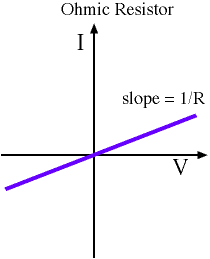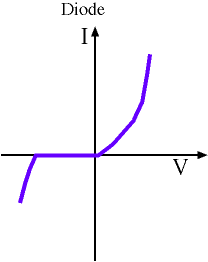|
|
|
|
|
|
|
|
When a steady current is made to flow
through a metallic conductor, by maintaining a steady potential
difference V across it, the current produced I, is experimentally
found to be proportional to the potential difference. Thus it is
found the the ratio V / I remains constant.
This V / I is called the
resistance, R, of the
metallic conductor.
|
|
|
|
|
|
|
|
 This
is called Ohm's Law. The
situation is shown in a graph to the left. Note that the graph is a
straight line, passing through the origin, and the graph is
symmetrical about the origin. In other words: if the terminals of the
battery applied across the conductor are reversed, one gets the same
magnitude of current, but in the opposite sense.
This
is called Ohm's Law. The
situation is shown in a graph to the left. Note that the graph is a
straight line, passing through the origin, and the graph is
symmetrical about the origin. In other words: if the terminals of the
battery applied across the conductor are reversed, one gets the same
magnitude of current, but in the opposite sense.
Units of resistance:
From the definition:
|
|
|
|
|
|
|
|
||
|
|
|
[The unit of resistance is equal to the unit of voltage divided by current, which are the V (Volt) and A (Ampere)].
In honor of Georg Simon Ohm (1789 - 1854), the unit of resistance
is called the Ohm (
|
|
|
|
|
|
|
|
 It is
important to note that Ohm's Law is not always valid, but it is a
good empirical rule for most systems. One does come across situations
in which the current is not proportional to the applied potential
difference, for example in a semiconductor diode, or in the
electrolysis of many electrolytes. Fortunately, these topics lead a
little too far from the purpose of this course. So will limit
ourselves to the cases where Ohm's Law is valid.
It is
important to note that Ohm's Law is not always valid, but it is a
good empirical rule for most systems. One does come across situations
in which the current is not proportional to the applied potential
difference, for example in a semiconductor diode, or in the
electrolysis of many electrolytes. Fortunately, these topics lead a
little too far from the purpose of this course. So will limit
ourselves to the cases where Ohm's Law is valid.
© MultiMedia Physics 2000